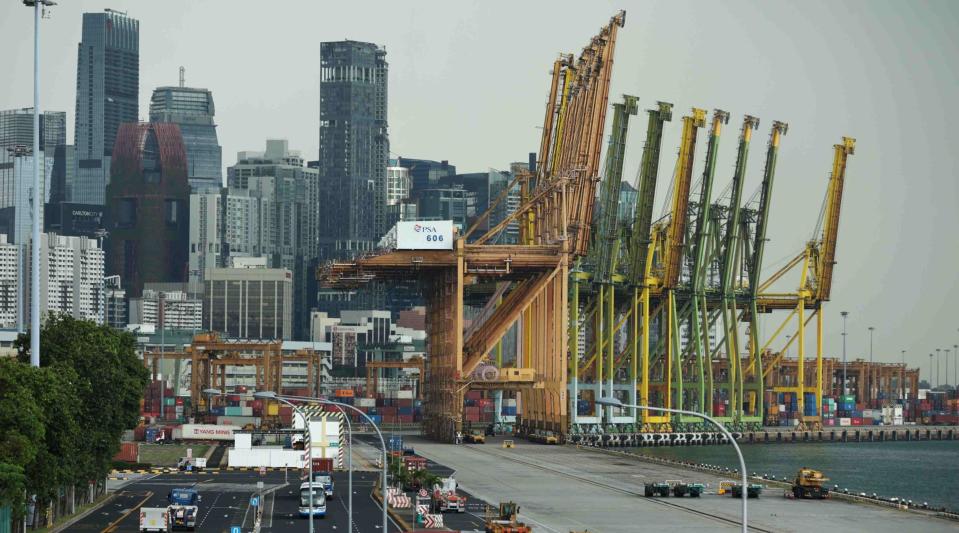'Low or mitigable' risk in ammonia bunkering in Singapore’s waters: GCMD, DNV study

Despite its toxicity and associated risks, green ammonia is one of the potential fuels that can decarbonise the shipping industry.
While ammonia-fuelled vessels are not yet available, an ammonia bunkering pilot in Singapore’s port waters could soon be a possibility, according to new findings by the Global Centre for Maritime Decarbonisation (GCMD) released on April 27.
GCMD and its appointed consultant, DNV Maritime Advisory (DNV), have completed a nine-month-long ammonia bunkering safety study commissioned in January 2022, with support from Surbana Jurong and the Singapore Maritime Academy (SMA) at the Singapore Polytechnic.
A public version of the report was released as part of Singapore Maritime Week. Full findings are compiled in a report titled “Safety and Operational Guidelines for Piloting Ammonia Bunkering in Singapore”, which will be released at a later date.
They found that the risks for conducting ammonia bunkering pilots in the Port of Singapore are low or mitigable. Given the small number of ammonia bunkering pilots that would be carried out annually, these risks will be below the individual risk thresholds set by the Major Hazards Department of the Ministry of Manpower, adds GCMD.
More than 400 potential risks were identified and assessed based on four technically feasible operational concepts: breakbulk and bunkering at anchorage, as well as shore-to-ship transfer and cross-dock transfer at two land-based sites for potential ammonia bunkering.
These risks are manageable with mitigation measures, says the consortium. The analysis showed that individual fatality and injury risks depend on the flow rate of ammonia, the number of transfer operations, duration per transfer operation and the length of piping and transfer arms.
The study’s findings pave the way for a pilot project to take place at three identified sites. Ammonia transfers in the port waters of Singapore will be first carried out with ammonia carriers to ready stakeholders of the ecosystem for an actual bunkering pilot when ammonia-fuelled vessels are on the water.
Despite its toxicity and associated risks, green ammonia is one of the potential fuels that can decarbonise the shipping industry, says GCMD. The report projects that ammonia will make up 10% of all marine fuels bunkered here in 2035.
Local regulatory authorities will now be able to use the report and its guidelines when deliberating on an ammonia bunkering pilot, they add.
Singapore is the world’s largest bunkering hub and second largest container port. Given the Port of Singapore’s proximity to dense residential areas and operations that see more than 1,000 ships a day, the study’s guidelines will likely be applicable to piloting ammonia bunkering at ports elsewhere, says GCMD.
GCMD was formed in August 2021 with a $120 million fund from Maritime and Port Authority of Singapore (MPA) and six founding partners; BHP, BW, DNV Foundation, Eastern Pacific Shipping, Ocean Network Express and Sembcorp Marine.
Based in Singapore, the non-profit organisation supports decarbonisation of the maritime industry to meet or exceed the International Maritime Organization’s (IMO) goals for 2030 and 2050.
Professor Lynn Loo, CEO of GCMD, says: “This report will inform and enable a GCMD pilot involving ship-to-ship transfer of ammonia in the port waters of Singapore. We are aiming for the first transfer of ammonia to take place by end-2023, subject to obtaining the greenlight from the relevant regulatory agencies.”
Loo adds: “Since ammonia-fuelled vessels are not yet available, we will be conducting the pilot with proxy assets to gain stakeholder competence and confidence so an actual bunkering exercise can commence when ammonia-fuelled vessels are on the water.”
On the ammonia bunkering guidelines, Knut Ørbeck-Nilssen, CEO of DNV Maritime, says: “Ammonia holds potential for a future maritime fuel and thus one pathway for the maritime industry’s decarbonisation journey. This project will help lay the safety considerations for ammonia bunkering… Further pilots and studies are key to understand, assess and mitigate safety risks associated with using ammonia fuel onboard the world fleet.”
Tan Wooi Leong, managing director, energy and industrial at Surbana Jurong, says: “The study will bolster Singapore’s position as an innovative and responsible global maritime hub leader as it seeks to decarbonise the maritime industry. This study gives authorities a very practical, comprehensive view of the costs associated with designing a port that supports the safe transfer and storage of this toxic but game-changing alternative fuel.”
Beyond the study
In preparation for the next phase of the GCMD project to execute an ammonia bunkering pilot in Singapore, GCMD is working with SMA to operationalise the manpower development framework for training operators to handle ammonia as a marine fuel.
Already, SMA has incorporated elements from the study to develop the first training course on the handling of ammonia under the International Code of Safety for Ships Using Gases or Other Low-flashpoint Fuels (IGF Code) and industry guidelines. This course took place for the first time in March, and registration is open for its next intake.
GCMD is also working closely with Oil Spill Response Limited to develop emergency response procedures, and will be sharing the full report with the Singapore Standards Council to support the development of a technical reference on ammonia bunkering.
Capt Chatur Wahyu, acting director of SMA, says: ”SMA had recently successfully conducted the Advanced IGF course where the topic on ammonia handling was covered during the programme. SMA is committed to contributing in the efforts towards green shipping and using ammonia as a future source of clean energy for the maritime industry. We hope to upskill more maritime talents to meet the needs of the industry’s changing landscape.”
See Also:
Click here to stay updated with the Latest Business & Investment News in Singapore
MPA signs agreements to explore maritime digitalisation and decarbonisation
Norway, Singapore, UN agency sign MOU on maritime decarbonisation
Get in-depth insights from our expert contributors, and dive into financial and economic trends

 Yahoo Finance
Yahoo Finance 